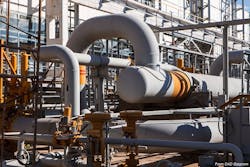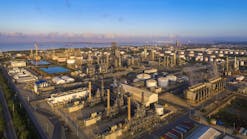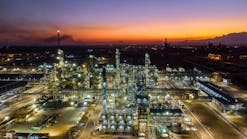Gazprom lets contract for Russian gas processing plant
OOO Gazprom Pererabotka Blagoveshchensk (GPB), a subsidiary of PJSC Gazprom, has partnered with NIPIgazpererabotka (Nipigaz), Moscow, on design and construction of a grassroots 49 billion-cu m/year natural gas processing plant to be built near the town of Svobodny in Russia’s Amur region.
Acting as contractor for the joint project, NIPIgaz will deliver engineering, procurement, and construction (EPC) management for the proposed Amur gas processing plant, which when commissioned, will become Russia’s largest, Gazprom and NIPIgaz said.
As part of the lump-sum turkey agreement, NIPIgaz, a subsidiary of Russian conglomerate PSJC Sibur Holding, will prepare project working documentation, supply equipment and materials, execute construction and installation activities, and transfer the plant to GPB upon mechanical completion, according to the service provider.
With main technical engineering solutions for the plant approved in January and design and survey operations now under way, Phase 1 of the plant’s construction, which includes predevelopment of the construction site, is scheduled to begin this year, Gazprom said in June.
Feedstock, logistics
The proposed plant comes as part of Gazprom’s implementation of its Eastern Gas Program (EGP), designed to integrate field developments, pipeline, and natural gas production centers in East Siberia and Russia’s Far East (OGJ Online, Nov. 1, 2012).
The Amur plant will receive multicomponent gas from EGP’s Irkutsk and Yakutia gas production centers via the Power of Siberia gas pipeline, with the plant’s process trains due to be commissioned in phases to coincide with development of gas production capacities in Yakutia and the Irkutsk region.
Gazprom synchronized development of gas production, construction of the pipeline, and start-up of gas processing activities specifically under the EGP framework (OGJ Online, May 11, 2015; Dec. 19, 2013).
In addition to producing ready-for-sale methane, ethane, propane, butane, and pentane-hexane fraction, the Amur gas processing complex also will include a 60 million-cu m/year helium plant to be supplied by feedstock from the Chayandinskoye field, which together with the company’s other reserves in East Siberia, forms one of the largest helium reservoirs in the world, according to Gazprom (OGJ Online, Dec. 19, 2012).
The Amur gas processing plant also will be connected to Sibur’s long-planned integrated ethylene, polyethylene, and polypropylene production complex now under construction at Tobolsk in Western Siberia’s Tyumen region (OGJ Online, Feb. 20, 2015).
Sibur will use the Amur plant’s 3.4 million-tonne/year production of ethane to produce polyethylene at the nearby complex, said Yury Vazhenin, director general of Gazprom subsidiary OOO Gazprom Pererabotka, in a June publication to company investors.
Gazprom—which announced on July 21 its change of status to a public joint-stock company as of July 17—established GPB as a special-purpose company dedicated to implement the Amur gas plant project.
Gas processing technology for the Amur plant will be provided by Linde AG and Air Liquide SA, according to Vazhenin.
Gazprom previously awarded a contract to JSC Cryogenmash to provide front-end engineering and design for units at the Amur gas processing plant, which include units for ethane and NGL recovery, nitrogen removal, fine helium purification, and helium liquefaction, Cryogenmash said in a Sept. 3, 2014, release.
The plant’s first process train is scheduled to be commissioned in 2018, according to Gazprom.
Eastward bound
The Amur gas processing center would further Gazprom’s 30-year natural gas supply agreement with China National Petroleum Corp., which the companies signed last year (OGJ Online, May 21, 2014).
The contract stipulates that 38 billion cu m/year will be supplied from Russia to China, with gas to be delivered via the Power of Siberia trunk line encompassing the Yakutia and Irkutsk production centers.
Contact Robert Brelsford at [email protected].


